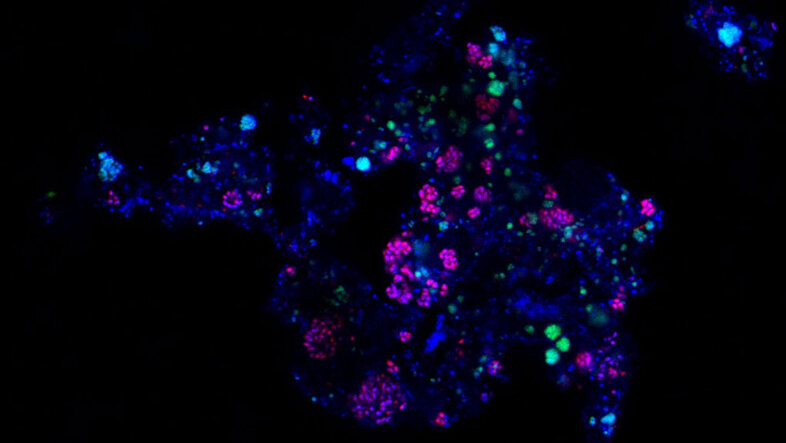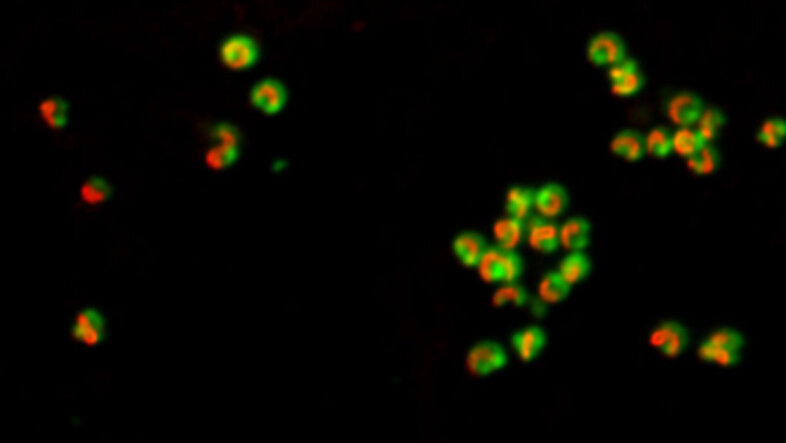Comammox: promising new player in the nitrogen cycle
Daring, novel, original – research that lies outside the current scientific understanding: Only project ideas that met these criteria have been funded within the "1,000 Ideas Programme" of the Austrian Science Fund (FWF). Among them was microbiologist Dimitra Sakoula from the University of Vienna: Her project "MarCo" will seek to push new frontiers by hunting for novel complete ammonia-oxidising microorganisms (comammox) in the ocean.
Detecting active microbes
What is daring about her project is not just that she's reaching out into the unknown – so far, nobody has detected comammox in the marine environment – but also her approach to searching for them. Sakoula, who is originally from Greece, is developing and applying a new method – together with the teams of Michael Wagner and Holger Daims at the University of Vienna – and searching for marine comammox with a new set of tools: "Of course, it could be true that there are no such microorganisms in marine environments, but I do not believe that. I think the reason why we have not found these microorganisms in the ocean yet is because we do not have the correct tools."
Comammox in the oceans: It is a big black box which needs to be filled either with a yes or a no, but it needs to be addressed.Dimitra Sakoula
Comammox: the complete ammonia oxidisers
So what is so special about the comammox bacteria? "They were discovered only in 2015 – luckily, I was one of the first PhD candidates who ever worked on these microorganisms – and they basically changed the whole theory of nitrification," explains Sakoula, who already started investigating these fascinating microbes during her PhD studies in the Netherlands. "Nitrification is a two-step process: First ammonium is oxidised to nitrite, and then the nitrite is oxidised to nitrate. For more than a hundred years, we believed that these two processes were performed by two different types of microorganisms. Comammox can perform both steps within a single cell."
Survive and thrive
So far, all comammox microorganisms detected are bacteria and belong to the genus Nitrospira. They can be found in a lot of engineered and natural ecosystems, from water treatment systems to lakes, forest and fields. "But although scientists have searched a lot, they could not find them in the ocean," says Dimitra Sakoula, "Which is strange. The ocean should – theoretically – be an ideal home for these microorganisms. Comammox bacteria seem to be extremely good at securing and scavenging even the smallest amounts of their preferred food – ammonia. Thus, they can grow in environments with very limited availability of ammonia, something that is especially true for marine environments."
Missing the hidden diversity?
Sakoula thinks that there might be other, not yet known comammox organisms out there. They could be bacteria that are not even related to the Nitrospira, or even some archaea, another type of microorganism: "What if we are missing all this hidden diversity because we are too focused on what we think we already know – like we were convinced that nitrification is a two-step process before we discovered comammox? Or we simply do not have the right tools to look 'outside the box'? This is why we are currently developing a new, activity-based method to detect novel comammox organisms."
Thrilling field of method development
Sakoula and her team, inspired by a technique used for drug discovery, are working hard at optimising and establishing this new method. Cutting a complicated technique short: cells are incubated with nitrite and a set of modified biomolecules – and if they are comammox, they will light up in two different colours under the microscope. "Once we find a new comammox organism, we separate them from the rest of the microorganisms in a sample, cultivate them and aim to provide a full characterisation of these microorganisms."
Important key players missing
Bioavailable nitrogen is essential for life in the oceans and the functioning of marine ecosystems. Nitrate is the most abundant (88 per cent) form of inorganic bioavailable nitrogen in the oceans and is a product of the nitrification process.
Scientists currently believe that the nitrification process in the oceans only functions as a close collaboration between mostly ammonium-oxidising archaea and nitrite-oxidising bacteria. So what if comammox can really be found in the ocean? "It will change our understanding of marine nitrification. Since this process is important for the stability of marine ecosystems, understanding a missing part of the whole story will be crucial in how we expect the oceans to respond to global environmental changes such as a rise in temperature or pollution."
Chasing your dreams is worth it. I believe it works out in the end.Dimitra Sakoula
Planetary health – the role of comammox
"Nitrogen pollution is one of our biggest problems. Really understanding the processes and drivers of the nitrogen cycle in all sorts of different ecosystems is crucial, and becoming even more important now," says Dimitra Sakoula, "In order to feed a growing human population we need to use fertilisers containing nitrogen in agriculture. Unfortunately, because of nitrogen-transforming microorganisms, a large proportion of fertiliser nitrogen is lost to water bodies where it causes eutrophication, or is released into the atmosphere in the form of harmful greenhouse gases. It will not be possible to effectively predict and counteract these side effects of fertilisation, unless we understand all the key players and processes involved."
According to the microbiologist, comammox is a big unknown factor so far, especially in the oceans. "We might have zero clue about nitrification in the oceans – which make up 75 per cent of the Earth’s surface – and if comammox are involved, it would be a very big deal," Sakoula is certain, "Knowing where and how we can find these organisms, how they function and what their characteristics are is super important, because nitrogen is increasingly interfering with the planet's health. But we need to feed the global population and we cannot avoid using fertilisers. Thus, we need to figure out a way to do so more efficiently and understanding comammox might help."


